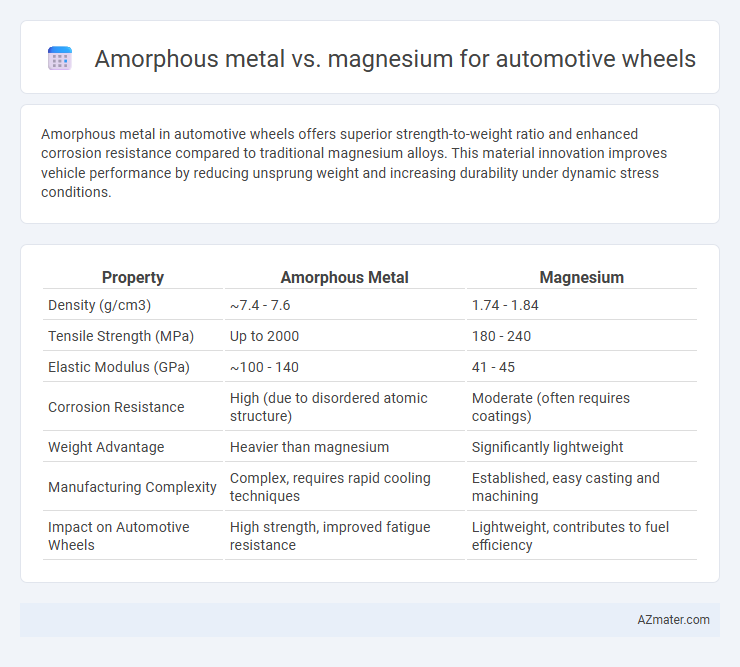Amorphous metal in automotive wheels offers superior strength-to-weight ratio and enhanced corrosion resistance compared to traditional magnesium alloys. This material innovation improves vehicle performance by reducing unsprung weight and increasing durability under dynamic stress conditions.
Table of Comparison
| Property | Amorphous Metal | Magnesium |
|---|---|---|
| Density (g/cm3) | ~7.4 - 7.6 | 1.74 - 1.84 |
| Tensile Strength (MPa) | Up to 2000 | 180 - 240 |
| Elastic Modulus (GPa) | ~100 - 140 | 41 - 45 |
| Corrosion Resistance | High (due to disordered atomic structure) | Moderate (often requires coatings) |
| Weight Advantage | Heavier than magnesium | Significantly lightweight |
| Manufacturing Complexity | Complex, requires rapid cooling techniques | Established, easy casting and machining |
| Impact on Automotive Wheels | High strength, improved fatigue resistance | Lightweight, contributes to fuel efficiency |
Introduction to Amorphous Metals and Magnesium Alloys
Amorphous metals, also known as metallic glasses, exhibit a disordered atomic structure that offers superior strength, corrosion resistance, and wear properties compared to traditional materials. Magnesium alloys, widely used in automotive wheels, are valued for their lightweight nature and good mechanical performance but can be prone to corrosion and lower strength relative to amorphous metals. The distinct microstructural differences between amorphous metals and magnesium alloys significantly impact their performance and suitability for high-stress automotive wheel applications.
Material Composition and Structure Comparison
Amorphous metals feature a non-crystalline atomic structure with a random arrangement of atoms, offering exceptional strength and corrosion resistance compared to the crystalline, hexagonal close-packed structure of magnesium alloys commonly used in automotive wheels. Magnesium's light weight and good machinability make it popular, but its lower strength-to-weight ratio and susceptibility to corrosion limit its performance relative to amorphous metals. The homogenous atomic distribution in amorphous metals eliminates grain boundaries, enhancing fatigue resistance and wear properties critical for automotive wheel applications.
Mechanical Strength and Durability
Amorphous metal alloys exhibit superior mechanical strength and enhanced durability compared to magnesium alloys, owing to their non-crystalline atomic structure that mitigates dislocation movement and fatigue. Their high yield strength and excellent wear resistance make amorphous metals ideal for automotive wheels subject to dynamic loading and harsh operating conditions. Although magnesium offers low density and lightweight benefits, amorphous metals provide a better balance of toughness and longevity essential for maximizing wheel performance and safety.
Weight Advantages for Automotive Wheels
Amorphous metals offer significant weight advantages over traditional magnesium alloys in automotive wheels due to their higher strength-to-weight ratio, enabling thinner and lighter wheel designs without compromising structural integrity. These advanced alloys reduce unsprung mass, which improves vehicle handling, fuel efficiency, and overall performance compared to magnesium wheels. Lightweight amorphous metal wheels also demonstrate better resistance to fatigue and wear, contributing to longer wheel lifespan and enhanced safety standards in automotive applications.
Corrosion Resistance Properties
Amorphous metals exhibit superior corrosion resistance in automotive wheels compared to magnesium due to their non-crystalline structure, which minimizes grain boundaries and reduces susceptibility to corrosion. Magnesium, while lightweight, is prone to rapid oxidation and galvanic corrosion in harsh environments, necessitating protective coatings that may degrade over time. The enhanced corrosion resistance of amorphous metals contributes to longer wheel lifespan and reduced maintenance costs in automotive applications.
Manufacturing Processes and Scalability
Amorphous metal automotive wheels are produced through rapid solidification techniques such as melt spinning or high-pressure die casting, offering exceptional strength and wear resistance but facing challenges in large-scale manufacturing due to slow cooling rates and costly equipment. Magnesium wheels benefit from well-established casting and forging processes like sand casting, gravity die casting, and thixomolding, allowing for efficient mass production with lower energy consumption. Scalability favors magnesium wheels for automotive applications because of existing industrial infrastructure and faster production cycles, whereas amorphous metals remain primarily suited for niche or high-performance uses with limited scalability.
Cost Analysis: Production and Market Viability
Amorphous metal wheels exhibit higher production costs due to complex manufacturing processes like rapid solidification, limiting their current market viability for automotive applications. Magnesium wheels offer cost advantages with established casting and machining methods, yielding lightweight designs favored for mass production and affordability. Market demand prioritizes magnesium's cost-efficiency and scalability despite amorphous metals' superior strength-to-weight ratios, influencing automotive manufacturers' material selection.
Thermal Performance and Heat Dissipation
Amorphous metal exhibits superior thermal performance and heat dissipation compared to magnesium in automotive wheels due to its unique atomic structure that enables rapid heat transfer and reduces thermal conductivity variations. Magnesium wheels, while lightweight, tend to retain more heat under high-stress driving conditions, which can lead to accelerated material fatigue and reduced braking efficiency. The enhanced heat dissipation properties of amorphous metals contribute to improved durability and performance stability in high-temperature automotive environments.
Design Flexibility and Aesthetics
Amorphous metals offer superior design flexibility for automotive wheels due to their unique atomic structure, enabling complex shapes and intricate patterns that traditional magnesium alloys struggle to achieve. Their high strength-to-weight ratio allows for thinner, more visually striking wheel designs without compromising durability. Magnesium wheels, while lightweight and cost-effective, often face limitations in aesthetic complexity and design innovation compared to amorphous metal alternatives.
Future Trends: Amorphous Metal and Magnesium in Automotive Innovation
Amorphous metal exhibits superior strength-to-weight ratio and corrosion resistance compared to traditional magnesium alloys, enhancing automotive wheel durability and performance. Emerging manufacturing techniques like additive manufacturing enable complex geometries in amorphous metal wheels, reducing weight and improving fuel efficiency. Future automotive innovation trends focus on combining lightweight magnesium with amorphous metal coatings to optimize strength, cost-efficiency, and recyclability in wheel design.

Infographic: Amorphous metal vs Magnesium for Automotive wheel
 azmater.com
azmater.com